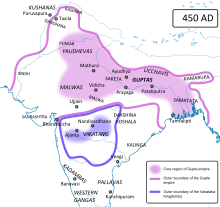Pushyamitras


The Pushyamitras were a tribe who lived in Central India during the 5th century CE. Living on the banks of the river Narmada, they are believed to have posed a serious threat to the Gupta Empire during the late period of Kumaragupta I's reign.
Origin
K. P. Jayaswal believed that the Pushyamitras were in western Malava and were known, in the Gupta period, as Avantyas who were under or in the confederacy of the Abhiras.[1]
History
The Puranas record thirteen kings of the Pushyamitra dynasty and have been placed in the 3rd century of the Common Era.[2]
Existence
The Pushyamitras are only known from the inscription of Skandagupta in which he emphasizes his role in defeating the Pushyamitras, of which the reading is sometimes disputed (it could be "Yudhy-amitrdths-cha" rather than "Pushyamitrams-cha"), as well as a single mention in the Puranas.[3] Therefore their existence is sometimes doubted. The people Skandagupta fought could more probably have been a confederation including the Vakatakas.[3] The dynasty of the Vakatakas ended around that time in a war, when, according to the Dashakumaracharita, attacking the area of Vanavasi to the south, they were in turn attacked from the rear resulting in the death of the last Vakataka king.
War against the Guptas
Inscriptions covering the events between 455 and 467 CE emphasize the role of Skandagupta, Kumaragupta's successor, in defeating the Pushyamitras.[4]
By whom, when [Skandagupta] prepared himself to restore the fallen fortunes of (his) family, a (whole) night was spent on a couch that was the bare earth; and then, having conquered the Pushyamitras, who had developed great power and wealth, he placed (his) left foot on a footstool which was the king (of that tribe himself).
— Line 10, Bhitari pillar inscription of Skandagupta[5]
The Pushyamitras were subjugated by Skandagupta after a long and strenuous fight,[6] as they "had developed great power and many resources in terms of military & wealth".[6][2][3]The inscription says that at one point the situation became so serious that Skandagupta had to pass a whole night on the bare ground (the field).[6] The critical situation was eventually tided over by him & emerged victorious.[2]This victory took place towards the close of Kumaragupta's reign. So Kumaragupta was probably too old to lead the army himself. So his son Skandagupta bore the brunt of the struggle, who was chosen by him to deal with the danger of the Pushyamitras.[6][3] This victory was so memorable & important, we are told in the Bhitari inscription that people sang the songs of his glory in every nook and corner of the empire.[2][3] Goyal thinks that the Pandumvamshi king Bharatabala was the king leading the Pushyamitra rebellion.[6]
See also
References
- ^ The Indian Historical Quarterly. Calcutta Oriental Press. 1961. p. 282.
- ^ a b c d Ashvini Agrawal (1989). Rise and Fall of the Imperial Guptas (Hardcover). Motilal Banarsidass. p. 211. ISBN 9788120805927.
- ^ a b c d e Cultural Contours of India by Vijai Shankar Śrivastava p.103
- ^ Kulke, Hermann; Rothermund, Dietmar (2004). A History of India (4. ed.). New York [u .a.]: Routledge. p. 96. ISBN 0415329191. Retrieved 22 August 2015.
- ^ Tripathi, Ram Prasad (1981). Studies in political and socio-economic history of early India. Neeraj Prakashan. p. 37.
- ^ a b c d e Bindeshwari Prasad Sinha (1977). Dynastic History of Magadha: Cir. 450-1200 A.D. Abhinav Publications. p. 22. ISBN 9780883868218.